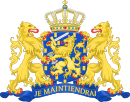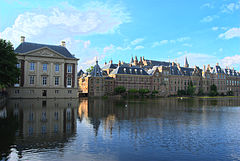Prime Minister of the Netherlands
| Prime Minister of the Netherlands | |
|---|---|
| Minister-president van Nederland | |
 | |
since 2 July 2024 | |
| Ministry of General Affairs | |
| Type | Head of government (de facto) |
| Member of | |
| Residence | Catshuis, The Hague |
| Seat | Torentje, The Hague |
| Appointer | Monarch of the Netherlands |
| Term length | Four years, renewable |
| Inaugural holder | Gerrit Schimmelpenninck |
| Formation | 25 March 1848 |
| Deputy | Deputy Prime Minister |
| Salary | €186,414 annually[1] |
| Website | www |
The prime minister of the Netherlands (Dutch: Minister-president van Nederland) is the head of the executive branch of the Government of the Netherlands.[2][3][4] Although the monarch is the de jure head of government, the prime minister de facto occupies this role as the officeholder chairs the Council of Ministers and coordinates its policy with the rest of the cabinet. In his role as the de facto head of government, the prime minister also represents the Netherlands in the European Council. Fourty-three men has served in the position. The current prime minister, Dick Schoof, has been in the position since 2 July 2024, with his cabinet being sworn in on the same day.[5]
History
[edit]Gradually the prime minister became an official function of government leader, taken by the political leader of the largest party. Since 1845, the role of the first minister is relevant. In that year the Constitution of the Netherlands was amended to make ministers responsible to the States General and no longer responsible to the king, who acted as the leader of cabinet. Until 1901, the position chair of the Council of Ministers officially rotated between ministers. Between 1901 and 1945, the position formally still rotated, but prominent politicians could claim a rotation period of four years.
In 1937, a separate Ministry of General Affairs was instituted, which was informally linked to the prime minister. Barend Biesheuvel (1971–1974) was the last prime minister who was not the political leader of the largest party in cabinet (his was actually the third largest), until the appointment of Dick Schoof (2024-present) who is an independent politician chosen to lead the right wing coalition. In 1983 the function of prime minister was laid down in the constitution.
The position of the prime minister has been reinforced by the creation of the European Council.[6] In November 2006, the rules of procedure of the council of ministers was changed to allow the prime minister to put any item on the agenda of the council and no longer have to wait for a minister to take the initiative.[7] A change of the rules of procedure of the cabinet in July 2008 allowed the prime minister to manage costs of the Royal House across departments, to make one department in control of cost of the Royal House which are covered by several ministries.[8]
Role
[edit]Although the prime minister is the leading Dutch political figure and holder of the de facto highest office, they are not as powerful as, for example, the British prime minister or the German chancellor. This is mainly because, historically, all Dutch ministers used to be responsible to the monarch (also true of prime ministers in other countries); ministers took turns to fill the position of prime minister, and in the role had little if any control over the other ministers. The prime minister's role gained importance when ministers became responsible to the parliament, and the position became mostly reserved for the leader of the biggest political party in the House of Representatives. Still, because the position holds limited powers compared to its equivalent in other neighboring parliamentary democracies, the prime minister's role is described as primus inter pares ("first among equals").[4]

Following the constitutional review of 1983, the position of prime minister was formalised in the Dutch Constitution for the first time.[9] According to the Constitution of the Netherlands, the Government is constituted by the king and the ministers.[10] The Constitution stipulates that the prime minister chairs the Council of Ministers (article 45) and is appointed by royal decree (article 43). The royal decree of their own appointment and those of the other ministers are to be countersigned by the prime minister (article 48). The Council of Ministers is no longer attended by the king.
The prime minister chairs the weekly meetings of the Council of Ministers and has the power to set the agenda of these meetings. The prime minister is also Minister of General Affairs (Minister van Algemene Zaken), which takes an important role in coordinating policy and is responsible for the Government Information Service (Dutch: Rijksvoorlichtingsdienst).
The prime minister is also responsible for the royal house and has a weekly meeting with the king on government policy. Informally the prime minister functions as the "face" of the cabinet to the public. After the meetings of the cabinet on Friday, the prime minister hosts a press conference on the decisions of the cabinet and current affairs. The prime minister also has some functions in international affairs, attending the European Council every six months and maintaining bilateral contacts. The prime minister's office has since the 1980s been an octagonal tower, named "The Little Tower" (Torentje), in the Binnenhof in The Hague. The official residence (which is only used for official functions) is the Catshuis; the last prime minister to live in the Catshuis was Dries van Agt. During his tenure, Mark Rutte lived in a flat in downtown The Hague. The prime minister has a security detail and which, in 2021, was increased amid fears of kidnapping.[11]
Although prime ministers are almost always the political leader of their party and as such chosen as a member of the House of Representatives, they (and other ministers who were chosen as representative) are required to give up their seat for the duration of their tenure, as Dutch ministers are not allowed to be members of parliament.
Appointment
[edit]| Part of the Politics series |
![Azure, billetty Or a lion with a coronet Or armed and langued Gules holding in his dexter paw a sword Argent hilted Or and in the sinister paw seven arrows Argent pointed and bound together Or. [The seven arrows stand for the seven provinces of the Union of Utrecht.] The shield is crowned with the (Dutch) royal crown and supported by two lions Or armed and langued gules. They stand on a scroll Azure with the text (Or) "Je Maintiendrai" (French for "I will maintain".)](http://upload.wikimedia.org/wikipedia/commons/thumb/8/8f/State_coat_of_arms_of_the_Netherlands.svg/150px-State_coat_of_arms_of_the_Netherlands.svg.png) |
|---|
|
|
The Dutch electoral system makes it all but impossible for one party to win an outright majority in the House of Representatives; no party has done so since 1900. Hence, Dutch governments are always coalitions between two or more parties. Following the most recent elections, the House appointed a "scout" to seek advice on how to interpret the election results (a role coordinated by the monarch prior to 2012). On the basis of this advice, the House appoints an informateur to check on prospective coalitions and lead negotiations between potential partners. If successful, the House then appoints a formateur, who concludes the talks between the members of the prospective coalition. The formateur is almost always the leader of the largest party in the prospective coalition, and thus de facto prime minister-designate. Prior to 2012, the monarch had a considerable role in this process in particular during the initial phases and the appointment of informateurs and formateurs. Reforms in 2012 pulled these tasks to the House of Representatives, thus largely eliminated royal influence on the process.
It usually takes several months of negotiations before a formateur is ready to accept a formal royal invitation to form a government. The monarch then appoints the ministers and state secretaries (junior ministers), who then resign their seats in the House or other job if appointed without being a representative.
The second largest coalition parties usually provides the senior Deputy Prime Minister of the Netherlands. If there are more parties in the coalition, generally they also each appoint one of their ministers to deputy prime ministers.[12]
Deputies
[edit]The king appoints deputy prime ministers. Conventionally, all of the junior partners in the coalition get one deputy prime minister; they are ranked according to the size of their respective parties. The senior deputy present chairs the cabinet meeting when the prime minister is not present. In the current Schoof cabinet, Fleur Agema chairs those meetings as first deputy prime minister of the Netherlands, with the other deputies being Sophie Hermans, Eddy van Hijum, and Mona Keijzer. The oldest member of the cabinet chairs the meeting when the prime minister and all deputies are absent.
Kingdom of the Netherlands
[edit]The prime minister is also chairman of the Council of Ministers of the Kingdom of the Netherlands, and therefore also deals with matters affecting the other countries Aruba, Curaçao, and Sint Maarten in the kingdom. The independent cabinets of Aruba, Curaçao, and Sint Maarten also have their own prime ministers: Evelyn Wever-Croes (Prime Minister of Aruba), Gilmar Pisas (Prime Minister of Curaçao), and Luc Mercelina (Prime Minister of Sint Maarten). The Council of Ministers of the Kingdom of the Netherlands includes ministers plenipotentiary from the other countries of the kingdom. These are not included in the government of the kingdom.
See also
[edit]- List of prime ministers of the Netherlands
- Historical rankings of prime ministers of the Netherlands
- Religious affiliations of prime ministers of the Netherlands
Footnotes
[edit]- ^ "Salaris minister, staatssecretaris en bestuurders provincies en gemeenten". Rijksoverheid. 7 July 2014.
- ^ Grondwet voor het Koninkrijk der Nederlanden [Constitution of the Kingdom of the Netherlands], article 45 section 2.
- ^ Van der Pot, C.W., Donner, A.M.: Handboek van het Nederlandse staatsrecht [Handbook of Dutch Constitutional Law], page 344-345. Zwolle: W.E.J. Tjeenk Willink, 1983.
- ^ a b "Minister-president – Parlement & Politiek". Parlement.com. 21 March 2002. Retrieved 23 April 2012.
- ^ "Kabinet-Rutte IV beëdigd – Nieuwsbericht – Rijksoverheid.nl". 10 January 2022.
- ^ Van der Pot, 345
- ^ Van Middelaar, Luuk: De passage naar Europa. Geschiedenis van een begin [The Passage to Europe. History of A Beginning], page 409. Groningen: Historische Uitgeverij 2009.
- ^ "Balkenende rotzooit met staatsrecht", NRC Handelsblad, 10 July 2008.
- ^ Van der Pot, 344.
- ^ Grondwet voor het Koninkrijk der Nederlanden, article 42, section 1: "De regering wordt gevormd door de Koning en de ministers."
- ^ 'Extra security for Rutte amid fears of growing underworld threat, dutchnews.nl (in English), 27-09-2021.
- ^ "(In)formateur en kabinetsformatie – Parlement & Politiek". Parlement.com. Archived from the original on 2 April 2016. Retrieved 26 January 2013.


